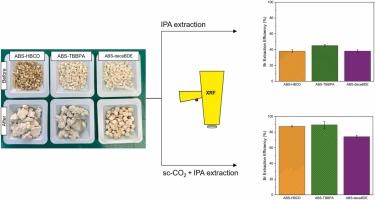Extraction of brominated flame retardants from acrylonitrile butadiene styrene (ABS) using supercritical carbon dioxide
IF 4.4
3区 工程技术
Q2 CHEMISTRY, PHYSICAL
引用次数: 0
Abstract
Electrical and electronic equipment, as well as construction materials, commonly contain brominated flame retardants (BFRs), which are harmful to human health and the environment. These additives can cause major issues during disposal or recycling phases and, hence, methods to remove them are highly demanded. This study focuses on removing three BFRs, namely Tetrabromobisphenol A (TBBPA), Decabromodiphenyl Ether (decaBDE), and Hexabromocyclododecane (HBCD) from acrylonitrile butadiene styrene (ABS) plastic using supercritical carbon dioxide (scCO2) extraction. Virgin ABS compounds with known BFR concentrations were prepared by melt extrusion and injection moulding, and the scCO2 extraction parameters, including extractor configuration, extraction time, pressure, temperature, type of co-solvents and physical dimensions of the sample, were optimized. To further remove the BFRs, samples were then cleaned in a pressure extractor with isopropanol (hybrid approach), achieving high BFR removal efficiency. The elemental bromine and BFR concentrations in the samples, both before and after the scCO2 extraction, were examined by X-ray fluorescence (XRF) analysis and mass spectrometry, respectively. In a semi-continuous configuration for the scCO2 extractor at 100 °C and ethanol co-solvent we effectively removed all three BFRs achieving a maximum bromine extraction of 84.3 % from ABS-TBBPA samples during 240 min. In the hybrid approach, the extraction increased to 89.4 % by treating the samples in the pressure extractor.

超临界二氧化碳萃取丙烯腈-丁二烯-苯乙烯(ABS)中溴化阻燃剂
电气和电子设备以及建筑材料通常含有对人体健康和环境有害的溴化阻燃剂(bfr)。这些添加剂在处理或回收阶段可能会引起重大问题,因此,迫切需要去除它们的方法。研究了超临界二氧化碳(scCO2)萃取法从丙烯腈-丁二烯-苯乙烯(ABS)塑料中脱除四溴双酚A (TBBPA)、十溴二苯醚(decaBDE)和六溴环十二烷(HBCD)三种溴化阻燃剂。通过熔融挤压和注射成型法制备了已知BFR浓度的ABS新化合物,并对萃取器配置、萃取时间、萃取压力、萃取温度、助溶剂类型和样品的物理尺寸等scCO2萃取参数进行了优化。为了进一步去除BFR,然后用异丙醇(混合方法)在压力萃取器中清洗样品,以获得较高的BFR去除效率。采用x射线荧光(XRF)分析和质谱法分别测定scCO2萃取前后样品中元素溴和BFR的浓度。在半连续配置的scCO2萃取器中,在100°C和乙醇共溶剂下,我们有效地去除了所有三种BFRs,在240min内从ABS-TBBPA样品中获得了84.3%的溴萃取。在混合萃取法中,样品在压力萃取器中处理,萃取率提高到89.4%。
本文章由计算机程序翻译,如有差异,请以英文原文为准。
求助全文
约1分钟内获得全文
求助全文
来源期刊

Journal of Supercritical Fluids
工程技术-工程:化工
CiteScore
7.60
自引率
10.30%
发文量
236
审稿时长
56 days
期刊介绍:
The Journal of Supercritical Fluids is an international journal devoted to the fundamental and applied aspects of supercritical fluids and processes. Its aim is to provide a focused platform for academic and industrial researchers to report their findings and to have ready access to the advances in this rapidly growing field. Its coverage is multidisciplinary and includes both basic and applied topics.
Thermodynamics and phase equilibria, reaction kinetics and rate processes, thermal and transport properties, and all topics related to processing such as separations (extraction, fractionation, purification, chromatography) nucleation and impregnation are within the scope. Accounts of specific engineering applications such as those encountered in food, fuel, natural products, minerals, pharmaceuticals and polymer industries are included. Topics related to high pressure equipment design, analytical techniques, sensors, and process control methodologies are also within the scope of the journal.
 求助内容:
求助内容: 应助结果提醒方式:
应助结果提醒方式:


